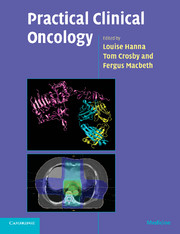Book contents
- Frontmatter
- Contents
- List of contributors
- Preface
- Acknowledgements
- Abbreviations
- 1 Practical issues in cytotoxic chemotherapy usage
- 2 Biological treatments in cancer
- 3 Hormones in cancer
- 4 Radiotherapy planning
- 5 Research in cancer
- 6 Oncological emergencies
- 7 Palliative care
- 8 Head and neck
- 9 Oesophagus
- 10 Stomach
- 11 Liver, gallbladder and biliary tract
- 12 Exocrine pancreas
- 13 Colon and rectum
- 14 Anus
- 15 Gastrointestinal stromal tumours
- 16 Breast
- 17 Kidney
- 18 Bladder
- 19 Prostate
- 20 Testis
- 21 Penis
- 22 Ovary
- 23 Body of the uterus
- 24 Cervix
- 25 Vagina
- 26 Vulva
- 27 Gestational trophoblast tumours
- 28 Lung
- 29 Mesothelioma
- 30 Soft tissue and bone tumours in adults
- 31 The lymphomas and myeloma
- 32 Central nervous system
- 33 Skin cancer other than melanoma
- 34 Melanoma
- 35 Thyroid
- 36 Neuroendocrine tumours
- 37 Cancer in children
- 38 Cancer of unknown primary
- 39 The use of radiotherapy in the treatment of benign conditions
- Multiple choice questions
- Multiple choice answers
- Index
- References
25 - Vagina
Published online by Cambridge University Press: 23 December 2009
- Frontmatter
- Contents
- List of contributors
- Preface
- Acknowledgements
- Abbreviations
- 1 Practical issues in cytotoxic chemotherapy usage
- 2 Biological treatments in cancer
- 3 Hormones in cancer
- 4 Radiotherapy planning
- 5 Research in cancer
- 6 Oncological emergencies
- 7 Palliative care
- 8 Head and neck
- 9 Oesophagus
- 10 Stomach
- 11 Liver, gallbladder and biliary tract
- 12 Exocrine pancreas
- 13 Colon and rectum
- 14 Anus
- 15 Gastrointestinal stromal tumours
- 16 Breast
- 17 Kidney
- 18 Bladder
- 19 Prostate
- 20 Testis
- 21 Penis
- 22 Ovary
- 23 Body of the uterus
- 24 Cervix
- 25 Vagina
- 26 Vulva
- 27 Gestational trophoblast tumours
- 28 Lung
- 29 Mesothelioma
- 30 Soft tissue and bone tumours in adults
- 31 The lymphomas and myeloma
- 32 Central nervous system
- 33 Skin cancer other than melanoma
- 34 Melanoma
- 35 Thyroid
- 36 Neuroendocrine tumours
- 37 Cancer in children
- 38 Cancer of unknown primary
- 39 The use of radiotherapy in the treatment of benign conditions
- Multiple choice questions
- Multiple choice answers
- Index
- References
Summary
Introduction
Primary carcinoma of the vagina is a rare condition that mainly affects older women. One of the main risk factors is persistent human papilloma virus (HPV) infection. Treatments are individualised, and treatment decisions are based on factors that include the site, size and stage of the tumour, and which adjacent structures are involved.
Tumours affecting the vagina
The most common malignant tumours affecting the vagina are tumours that have spread from adjacent structures (cervix and vulva). Table 25.1 shows the range of tumours that can affect the vagina (adapted from WHO Classification, 2003).
Anatomy
The vagina is a muscular tube about 8 cm long, and it extends upwards and backwards from the vulva to the uterus. The apex of the vagina, into which the cervix projects, is divided into four fornices: anterior, posterior, and two lateral.
The relations of the vagina from superior to inferior are as follows:
Anterior – bladder, urethra.
Posterior – pouch of Douglas, rectum, perineal body (separates lower vagina from anus).
Lateral – ureter, pelvic floor and perineal muscles.
The lymphatic drainage from the upper two-thirds is to the pelvic nodes, and from the lower third to the inguinal nodes.
Incidence and epidemiology
Vaginal cancer is rare; the annual disease incidence in the UK is 0.7 in 100,000 women. Approximately 180 new cases are diagnosed per year in England (National Statistics, 2005), and vaginal cancer accounts for approximately 1 to 2% of all gynaecological malignancy. The mortality-to-incidence ratio is 0.53 (National Statistics, 2005).
- Type
- Chapter
- Information
- Practical Clinical Oncology , pp. 290 - 295Publisher: Cambridge University PressPrint publication year: 2008



